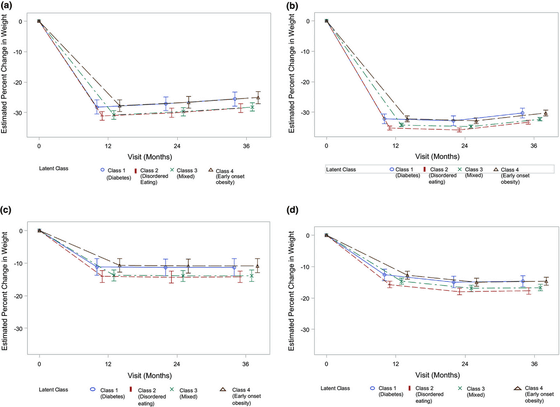Obesity can be categorized into 4 types, what are the characteristics and trends by type?

Turbulence of lifestyle habits and drinking and eating brought over cause obesity and underlie various complications. In many cases, although overweight is overcome by reviewing everyday living and exercising moderately, obesity can be eliminated, but the means called "weight loss surgery" that physically restrains the volume of the stomach by surgical operation and measures obesity is taken Sometimes. A research team at Brown University analyzes the data of persons who have suffered from obesity and who undergo weight reduction surgery, and has published a thesis that obesity is classified mainly into four types.
Association of Obesity Subtypes in the Longitudinal Assessment of Bariatric Surgery Study and 3-Year Postoperative Weight Change - Field - - Obesity - Wiley Online Library
https://onlinelibrary.wiley.com/doi/full/10.1002/oby.22287
Weight-loss surgery data reveals 4 types of obesity - Futurity
https://www.futurity.org/obesity-weight-loss-surgery-1912092-2/
Weight loss surgery (obesity surgery ), one of the treatments for obesity, is a surgical procedure performed to prevent or ameliorate complications caused by obesity such as diabetes and heart disease. There are various methods, such as "Rouye gastric bypass surgery" which cuts the stomach small and connects to the small intestine, and "stomach banding operation" to restrict the intake of food by winding a band around the stomach.
A research team led by Alison Field, Brown University's professor of epidemiology, analyzed the data of 2456 obese patients who underwent weight loss surgery, it was possible to classify obese patients into 4 groups, and dietary behavior · It was confirmed that the incidence of diabetes · weight loss during 3 years after surgery is greatly different.
According to the research team, obese patients have "class 1" with low " high-density lipoprotein (HDL)" which is so-called "good cholesterol", "class 2" with irregular meal, features of class 1 and class 2 at the same time "Class 3" which is held together, and "class 4" which was suffering from obesity from childhood.

by Sandra Cohen - Rose and Colin Rose
The number of obese patients belonging to low HDL class 1 is 91 out of 2456, the ratio between male and female is approximately 4: 6. The average of fasting blood glucose was very high, 246.5 which is more than double the standard value, 97.8% of the whole class 1 had type 2 diabetes. In addition, the average of triglyceride (TG) showing the amount of triglyceride in the blood is also 249, which is a value much higher than the reference upper limit of 150.
Meanwhile, in Class 2 patients who became obese due to irregular diet, people who are plagued by an overeating disorder (BED) who continues to eat foods without using vomiting (drowsiness) or laxatives mostly . There are 892 obese patients classified as Class 2, but the blood glucose level and TG average are within the reference value, the proportion of patients suffering from type 2 diabetes is 27.1% of the total, and in Class 1 I understood that it is low compared. In addition, the ratio of males and females was about 2: 8, and women overwhelmingly occupied obese patients classified as Class 2. In addition, more than 90% of the total answered "I will eat food even if it is not hungry," and over 60% of people realized that "people can not control meals".

There are 1108 people in Class 3 with low HDL and irregular meals among 2456 people. The proportion of type 2 diabetic patients is 31.2% and the ratio of male and female is approximately 2: 8, seemingly there seems to be little difference from Class 2 at first glance. However, unlike Class 2, it is not that he can not control eating, but he said that only 7% answered "I will eat food even if not hungry."
There were 365 patients in the class 4 who had obesity from early childhood, 365 out of 2456 patients, calculated an extremely high value of 58.3, while the average BMI was about 45 in other classes. We also found that 41.8% of Class 4 patients do not lose 4 meals a day and snacks.
The graph below shows the average body weight change over the three years after receiving weight loss surgery as a percentage. Graph (a) shows a man who received Ruwai gastric bypass surgery, graph (b) shows a Ruwai gastric bypass operation, graph (c) shows a stomach banding surgery, graph (d) shows a stomach banding operation Of a woman who received it. Blue is class 1, red is class 2, green is class 3, brown is class 4. Regardless of which graph you see, you can see that the effect of weight loss surgery is high in red class 2 and green class 3.

Mr. Field reported that there is a possibility that at least five classification types exist in obesity in previous studies, but there was no big research focusing on actually identifying the classification of obesity He states that identifying patients in these groups and understanding their characteristics will be useful for the study and treatment of obesity. Especially, it is particularly important to study the classification type of obesity in order to judge whether you will benefit from weight loss surgery which is the final means of treating obesity or not.
Following the results of this research, the research team concluded that "obesity is a heterogeneous disease, surgery for weight loss can be said to be the most useful means for adults with irregular meals," I am arguing. Also, Mr. Field says, "One of the reasons why there are not so many big discoveries in the field of obesity research is that obesity patients that should be classified into various types are classified as mutual. Prevention / treatment of obesity is effective Although it is something, the effect varies greatly depending on the group. "
Related Posts:
in Science, Posted by log1i_yk







